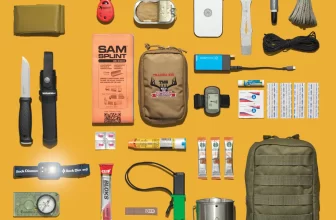
Have you ever wondered if it’s worth investing in lightweight or ultralight gear for your outdoor adventures? Maybe you’ve heard these terms thrown around but you’re not quite sure why they matter. Well, let me tell you, investing in lightweight or ultralight gear can make a world of difference when it comes to hiking, backpacking, or any other outdoor activity. In this article, we’ll delve deeper into the benefits of lightweight gear and how it can enhance your overall experience in the great outdoors. So, get ready to discover why going light might be the best decision you’ll ever make.
When you think about it, carrying heavy gear on your back for miles and miles can be pretty exhausting, right? Well, that’s where lightweight or ultralight gear comes in. These types of gear are specifically designed to be as light as possible without sacrificing functionality. They are made from innovative materials and feature smart designs that trim down unnecessary weight. By investing in lightweight gear, you’ll be able to bring more essential items with you without feeling burdened by extra pounds. Imagine how much easier it would be to navigate rugged terrains or climb steep hills with a lighter pack on your back.
Not only does lightweight or ultralight gear reduce the physical strain on your body, but it also allows you to cover more miles in a day. When you’re not weighed down by heavy gear, you can move faster and with less effort. This means you can explore more areas, reach higher peaks, and potentially even extend your outdoor trips. Additionally, lightweight gear often takes up less space, making it easier to pack efficiently and save room for other essentials. So, whether you’re planning a long-distance hike or a weekend camping trip, investing in lightweight or ultralight gear can be a game-changer.
In conclusion, investing in lightweight or ultralight gear is definitely worth it if you’re someone who loves spending time in the outdoors. Not only does it make your adventures more comfortable and enjoyable, but it also allows you to do and see more. Whether you’re a casual hiker or a seasoned backpacker, having gear that is lighter and more efficient can greatly enhance your overall experience. So, next time you’re gearing up for an outdoor expedition, consider investing in lightweight or ultralight gear. Trust me, you won’t regret it.
What is lightweight or ultralight gear?
Definition of lightweight gear
Lightweight gear refers to equipment and gear that are designed to be lighter in weight compared to traditional or standard gear. These items are specifically engineered to minimize unnecessary weight, allowing outdoor enthusiasts to carry less and move more efficiently.
Definition of ultralight gear
Ultralight gear is a subset of lightweight gear that takes the concept of minimal weight to the extreme. Ultralight gear is designed to be as lightweight as possible without compromising on functionality or durability. These items are often made from high-tech materials and utilize innovative designs to achieve the lowest possible weight.
Advantages of lightweight or ultralight gear
Reduced weight for easier carrying
One of the biggest advantages of investing in lightweight or ultralight gear is the reduced weight it offers. Carrying heavy gear can be a significant burden, especially on long hikes or multi-day trips. By opting for lighter gear, you can alleviate the strain on your back and joints, making your outdoor adventures more enjoyable.
Increased mobility and agility
Lightweight and ultralight gear can greatly enhance your mobility and agility in the outdoors. With less weight to carry, you can move more swiftly and effortlessly, enabling you to explore more areas and tackle challenging terrains with ease. This increased mobility allows you to have a more dynamic and exciting outdoor experience.
Less strain and fatigue on the body
Another benefit of lightweight gear is the reduced strain and fatigue it places on your body. Carrying heavy gear for extended periods can lead to muscle fatigue and discomfort. Lightweight and ultralight gear helps to minimize these issues, allowing you to conserve energy and enjoy your outdoor activities for longer periods without feeling exhausted.
Disadvantages of lightweight or ultralight gear
Higher cost compared to traditional gear
One drawback of investing in lightweight or ultralight gear is the higher cost associated with these products. Due to the advanced materials and technologies used in their construction, lightweight and ultralight gear tend to be more expensive than their traditional counterparts. However, it’s important to consider the long-term benefits and your priorities as an outdoor enthusiast.
Potential durability issues
Another potential disadvantage of lightweight gear is its decreased durability compared to heavier and more robust gear. Lightweight materials may not be as resistant to wear and tear, potentially leading to quicker deterioration of gear. However, advancements in materials and construction techniques have improved the durability of lightweight gear, making this concern less significant than in the past.
Limited capacity and storage
Lightweight and ultralight gear often have limited capacity and storage options compared to traditional gear. This can be a disadvantage for individuals who require a larger carrying capacity or need to carry bulkier items. It’s essential to carefully evaluate your specific needs and ensure that lightweight gear can accommodate your equipment and supplies effectively.
Factors to consider before investing
Type of outdoor activity
When deciding whether to invest in lightweight or ultralight gear, consider the type of outdoor activities you enjoy. Different activities have varying equipment demands, and lightweight gear may be better suited for certain pursuits. For example, lightweight gear is commonly used in backpacking and hiking, where weight is a crucial factor.
Duration of the activity
The duration of your outdoor activity is another important consideration. If you frequently embark on day trips or short outings, lightweight gear may not be as essential as it is for multi-day treks or expeditions. Longer trips require you to carry more supplies, making weight-saving gear more valuable to reduce fatigue.
Climate and weather conditions
The climate and weather conditions in the areas you plan to visit should also influence your decision to invest in lightweight or ultralight gear. In adverse weather, such as heavy rain or snow, lightweight gear may not provide the same level of protection and durability as heavier gear. Assess the conditions you are likely to encounter and ensure your gear can withstand them.
Cost-effectiveness of lightweight or ultralight gear
Comparing initial investment to long-term benefits
While lightweight and ultralight gear may have a higher upfront cost, it’s important to assess the long-term benefits and potential cost savings as well. Consider factors such as reduced wear and tear on your body, enhanced enjoyment during outdoor activities, and the potential for fewer gear replacements over time. These benefits can outweigh the initial investment.
Evaluating the frequency of use
Another factor to consider regarding cost-effectiveness is how frequently you will use the gear. If you are a frequent outdoor enthusiast who spends a significant amount of time in nature, investing in lightweight or ultralight gear can be seen as a worthwhile investment. However, if you only engage in occasional outdoor activities, it may be more reasonable to stick with traditional gear.
Impact on performance and experience
Enhanced performance due to reduced weight
Investing in lightweight or ultralight gear can have a positive impact on your performance during outdoor activities. With less weight to carry, you can move more efficiently and without unnecessary strain on your body. This improved performance allows you to cover greater distances, climb more challenging terrains, and ultimately achieve more ambitious outdoor goals.
Improved enjoyment and comfort during outdoor activities
The weight reduction provided by lightweight and ultralight gear also contributes to a more enjoyable and comfortable outdoor experience. With less physical fatigue, you can focus on the beauty of nature, connect with your surroundings, and fully immerse yourself in the outdoor environment. This enhanced level of comfort leads to a higher overall satisfaction with your outdoor adventures.
Suitability for different skill levels
Beginners and casual enthusiasts
Lightweight gear is particularly beneficial for beginners and casual outdoor enthusiasts. As newcomers to outdoor activities, beginners may struggle with the physical demands of carrying heavy gear. Lightweight gear can minimize this initial challenge and make outdoor pursuits more accessible and enjoyable. Additionally, beginners may not require the same level of durability or capacity as advanced adventurers, making lightweight gear a suitable choice.
Experienced and advanced adventurers
Experienced and advanced adventurers often prioritize lightweight gear due to the competitive edge it provides. These individuals typically have a deep understanding of their gear requirements and are willing to invest in optimized equipment for their specific activities. Ultralight gear, in particular, caters to the needs of experienced adventurers who aim to push their limits and achieve extraordinary feats.
Availability and variety of lightweight gear
Brands and manufacturers offering lightweight options
The demand for lightweight gear has grown significantly in recent years, leading to an increase in brands and manufacturers offering such options. Well-known outdoor gear brands like Patagonia, The North Face, and Osprey are just a few examples of companies that provide a wide range of lightweight and ultralight gear. This variety ensures that outdoor enthusiasts have ample choices when it comes to selecting suitable equipment.
Different types of gear available
Lightweight and ultralight gear are available for almost every aspect of outdoor activities. From backpacks and tents to sleeping bags and cookware, there is a lightweight option available for every piece of gear you may need. This extensive range allows you to fully outfit yourself with lightweight equipment, providing a comprehensive solution to reduce the overall weight of your gear.
Tips for selecting the right lightweight gear
Researching product reviews and ratings
Before purchasing lightweight gear, it’s essential to conduct thorough research on the specific products you are considering. Reading product reviews and ratings from fellow outdoor enthusiasts can provide valuable insights into the durability, functionality, and performance of different lightweight gear options. This information will help you make an informed decision and select gear that best suits your needs.
Considering individual needs and preferences
While lightweight gear is generally advantageous, it’s important to consider your individual needs and preferences when selecting gear. Consider factors such as the specific activities you engage in, your body type, and any unique requirements you may have. Customizing your gear selection based on these factors will help ensure that you invest in gear that aligns perfectly with your needs.
Testing and trying out gear before purchasing
Whenever possible, it is highly recommended to try out lightweight gear before making a purchase. Many outdoor gear stores offer the opportunity to test gear either through rentals or demo days. By physically trying out gear, you can assess its comfort, functionality, and suitability for your specific needs. This hands-on experience will greatly inform your decision-making process.
Conclusion
Weighing the pros and cons of lightweight or ultralight gear is essential for making an informed investment decision. While it may come with a higher cost, the benefits of reduced weight and increased mobility can greatly enhance outdoor experiences. Consider factors like activity type, duration, and personal preferences to determine the suitability of lightweight gear. Ultimately, the decision should align with individual goals and priorities. With the right lightweight gear, you can unlock new levels of enjoyment and performance in your outdoor pursuits.







